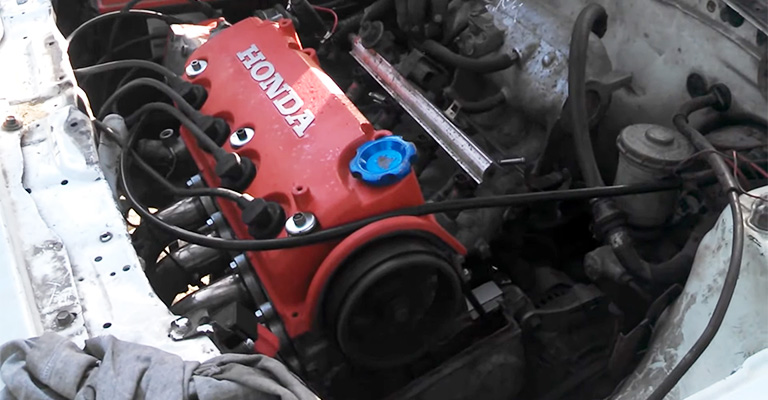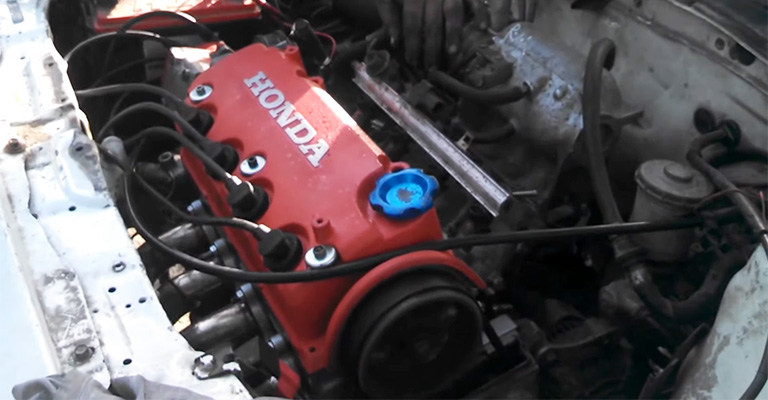The Honda D15A2 engine was first introduced in 1984 and was used in various Honda models until 1987. The engine was known for its fuel efficiency and reliability, making it a popular choice for compact vehicles.
The purpose of this blog post is to provide an in-depth review of the Honda D15A2 engine, including its specs, performance, and comparison with other engines in the market.
Whether you’re a car enthusiast or simply in the market for a new car, this review will give you a comprehensive understanding of the Honda D15A2 engine and its capabilities.

Honda D15A2 Engine Overview
The Honda D15A2 engine was a 1.5-liter, 4-cylinder engine produced by Honda from 1984 to 1987. It was designed for use in compact vehicles and was known for its fuel efficiency and reliability.
The engine was equipped with a 3-barrel carburetor with vacuum secondary and featured a 12-valve CVCC (Compound Vortex Controlled Combustion) SOHC (Single Overhead Camshaft) valvetrain.
The Honda D15A2 engine was offered in two versions, one with a compression ratio of 8.7:1 and another with a compression ratio of 9.6:1.
The Honda CRX HF model, equipped with the 8.7:1 compression ratio engine, produced 60 horsepower at 5,550 RPM and 73 lb-ft of torque at 3,500 RPM.
This engine was capable of reaching a redline of 5,500 RPM and had an economy rating of 49/54 miles per gallon. The gear ratios for the 49 State model were 3.272/1.666/1.041/0.807/0.714, with a final drive ratio of 4.066.
The Honda CRX DX model, equipped with the 9.6:1 compression ratio engine, produced 78 horsepower at 6,000 RPM and 73 lb-ft of torque at 3,500 RPM. This engine had a redline of 6,500 RPM and had an economy rating of 38 miles per gallon.
The gear ratios for this model were 2.916/1.764/1.181/0.846/0.714, with a final drive ratio of 4.266.
The Honda Civic Wagon RT4WD, available only in Canada, was equipped with a 9.2:1 compression ratio engine. This engine produced 76 horsepower at 5,500 RPM and 84 lb-ft of torque at 3,500 RPM.
This engine was equipped with a 12-valve SOHC valvetrain and had an economy rating of 31-38 miles per gallon.
Overall, the Honda D15A2 engine was a reliable and fuel-efficient option for compact vehicles during its production period. Its design and technology helped establish Honda’s reputation for producing quality engines that deliver both performance and efficiency.

Specification Table for D15A2 Engine
| Specification | Honda CRX HF | Honda CRX DX | Honda Civic Wagon RT4WD (Canada) |
|---|---|---|---|
| Displacement | 1,488 cc | 1,488 cc | 1,488 cc |
| Compression | 8.7:1 | 9.6:1 | 9.2:1 |
| Power | 60 hp | 78 hp | 76 hp |
| Torque | 73 lb-ft | 73 lb-ft | 84 lb-ft |
| Redline | 5,500 RPM | 6,500 RPM | – |
| Fuel induction | 3 barrel carb | 3 barrel carb | – |
| Valvetrain | 12v CVCC SOHC | 12V CVCC SOHC | 12 valves, SOHC |
| Economy | 49/54 mpg | 38 mpg | 31-38 mpg |
| Gear ratios | 3.272/1.666/1.041/0.807/0.714 (Final 4.066) | 2.916/1.764/1.181/0.846/0.714 (Final 4.266) | 2.916/1.526/0.960/0.750/0.655 (Final 2.954) |
Source: Wikipedia
Comparison With Other D15 Family Engine Like D15A1 and D15A3
Honda produced several other engines in the D15 engine family, including the D15A1 and the D15A3. Some differences between the D15A2 and these other engines include:
D15A1:
- Lower compression ratio (8.2:1)
- Lower power output (58 hp)
- More fuel-efficient (up to 57 mpg)
D15A3:
- Higher compression ratio (9.0:1)
- Higher power output (88 hp)
- The slight decrease in fuel efficiency (up to 44 mpg)
Overall, the D15A2 engine offered a balance between power and fuel efficiency, with a slightly lower compression ratio and power output compared to the D15A3, and slightly lower fuel efficiency compared to the D15A1.
It’s worth noting that these specifications will vary based on the specific year, make, and model of the vehicle in which each engine was used.
Head and Valvetrain Specs D15A2 Table
| Specification | Honda CRX HF | Honda CRX DX | Honda Civic Wagon RT4WD (Canada) |
|---|---|---|---|
| Valvetrain | 12v CVCC SOHC (8V ’84-’86) (8 (4) intake, 4 exhaust, 4 aux (for cvcc chamber)) | 12V CVCC SOHC (8 intake, 4 exhaust, 4 aux (for cvcc chamber)) | 12 valves, SOHC |
| Cylinder head | CVCC (Compound Vortex Controlled Combustion) | CVCC (Compound Vortex Controlled Combustion) | – |
The Technologies Used in
The Honda D15A2 engine utilized several technologies to improve its performance and efficiency. Some of these include:
1. Compound Vortex Controlled Combustion (Cvcc)
This was a unique combustion chamber design used in the cylinder head of the engine. It helped improve fuel efficiency and reduce emissions by using a pressurized air/fuel mixture in the center of the chamber, surrounded by a second outer layer of air.
2. 12-valve Sohc (Single Overhead Cam) Design
The D15A2 utilized a 12-valve design with a single overhead cam, which helped improve engine breathing and overall performance.
3. Vacuum Secondary Carburetor
The D15A2 was equipped with a 3-barrel carburetor with a vacuum secondary, which helped optimize fuel delivery and improve fuel efficiency.
4. High-revving Engine Design
The D15A2 was designed to rev higher than many other engines in its class, with a redline of 5,500 rpm (6,500 rpm in the CRX DX). This helped improve performance and response.
By utilizing these and other technologies, the Honda D15A2 engine was able to deliver a balance of power and fuel efficiency, making it a popular choice for many Honda vehicles in the 1980s and beyond.
Performance Review
The Honda D15A2 engine was designed to deliver a balance of power and fuel efficiency. With a 1.5-liter displacement and a compression ratio of 8.7:1 (9.6:1 in the CRX DX and 9.2:1 in the Civic Wagon RT4WD), the engine produced 60 horsepower (45 kW) at 5,550 rpm and 73 lb-ft (99 Nm) of torque at 3,500 rpm.
This was enough power to provide decent acceleration and overall performance in the Honda CRX HF, while still delivering impressive fuel economy of 49/54 mpg.
In the Honda CRX DX, the engine’s performance was improved thanks to its higher compression ratio, which allowed it to produce 78 horsepower (58 kW) at 6,000 rpm and the same 73 lb-ft of torque as the CRX HF. Despite the increased power, the engine still delivered solid fuel economy of 38 mpg.
In the Honda Civic Wagon RT4WD, the D15A2 engine was tuned to deliver even more power, producing 76 horsepower (57 kW) at 5,500 rpm and 84 lb-ft (114 Nm) of torque at 3,500 rpm. Despite this increased performance, the engine still delivered fuel economy of 31-38 mpg.
Overall, the Honda D15A2 engine was a reliable and efficient powerplant that delivered solid performance and fuel economy in a variety of Honda vehicles.
Whether you were looking for a budget-friendly option with impressive fuel efficiency, or a sportier engine that offered more power, the D15A2 had something to offer.
What Car Did the D15A2 Come in?
The Honda D15A2 engine was found in the following vehicles
- 1984-1987 Honda CRX HF
- 1984-1987 Honda CRX DX
- 1987 Honda Civic Wagon RT4WD (Canadian Model)
Other D Series Engines-

Leave a Reply